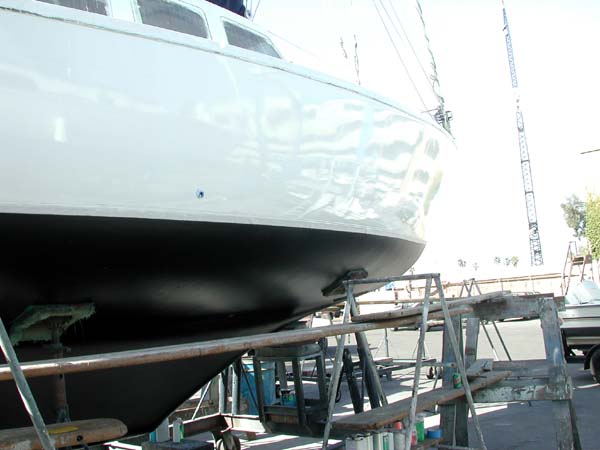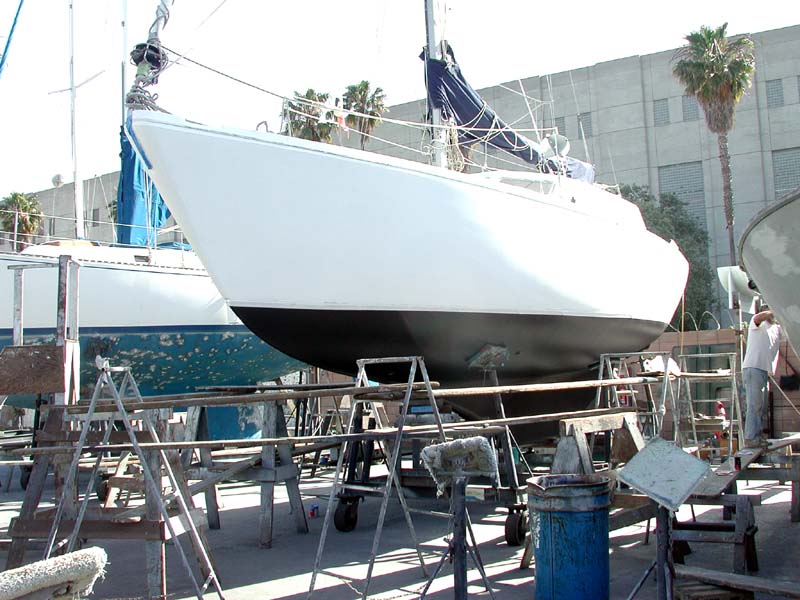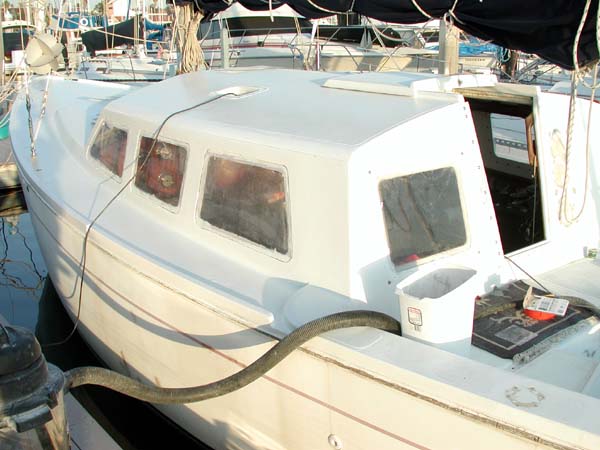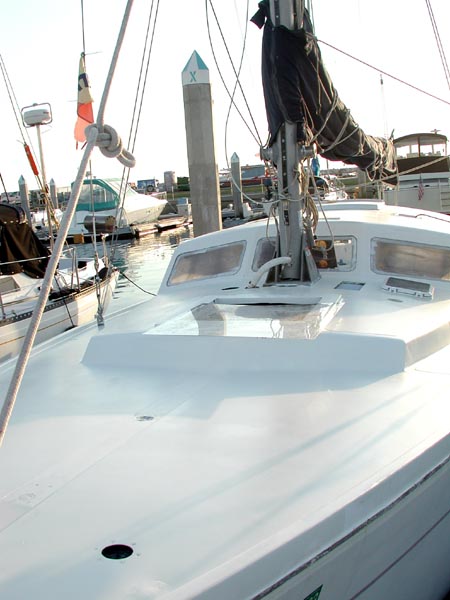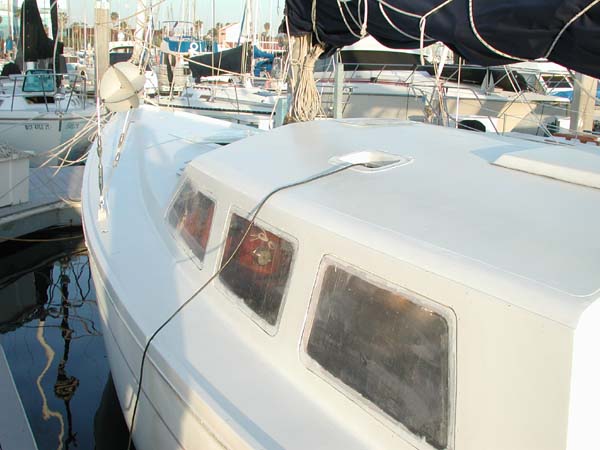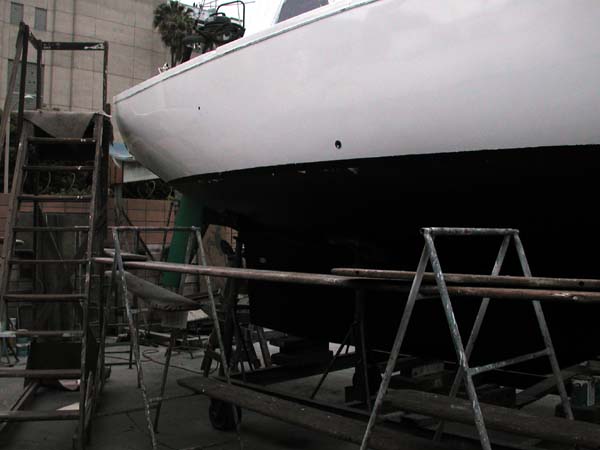The second round of painting was in Southern CA during the middle of the summer of 1999. Here flow was not much of a problem due to extended drying times, however, retaining gloss after the paint cured was problematic. Luckily I was only touching up some areas and I managed to get lucky.
The third round of painting is again in Southern CA during the spring of 2004. The loss of gloss overnight appears to be consistent and requires a more detailed understanding of the paint drying process to solve the problem.
The paint manufacturer has been the same for all three painting adventures. I use Interlux's Interthane Plus two part linear polyurethane. The only color I have worked with is white, I like the look of their white LP and use striping tape to create the cove and boot strip. I have not experimented with the other products because I have become comfortable with the Interlux system it's properties. I am specifically interested in a paint which works well with a brush and roller. (Note in the following discussion that product numbers are Interlux products)
The process I use for applying LP is comprised of the following steps:
1) Wipe down the area to be painted with 202 Dewaxer/Degreaser
2) Heavily sand area to be painted with 40 grit sandpaper using a
Porter Cable 6 inch random orbital sander
3) Wipe down sanded surface with 202 Dewaxer/Degreaser
4) Apply a coat of 404/414 Epoxy Primer thinned 25% with 2333N thinner
5) Heavily sand area with 80 grit paper, ensure all cracks, voids, and the
like were filled wipe down with 2333N
6) Apply a coat of 404/414 Epoxy Primer thinned 25% with 2333N thinner
7) Hand sand with 220 grit wet/dry sandpaper in the morning dew wipe down
with 2333N
8) Apply a coat of Interthane Plus thinned 40% with 2333N brushing thinner
9) Hand sand with 220 grit wet/dry sandpaper in the morning dew two days
later wipe down with 2333N
10) Apply a coat of Interthane Plus thinned 40% with 2333N brushing
thinner
11) Hand sand with 320 grit wet/dry sandpaper in the morning dew two days
later wipe down with 2333N
Now the entire deck is basically one color, the voids have been filled and the imperfections are down to an acceptable level (remember she's not a Oyster!), now the idea is to paint all of the smooth surfaces and get a good gloss.
12) Apply a coat of Interthane Plus thinned 40% with 2333N brushing thinner to the smooth surfaces early in the morning on a dry day
Now all of the shiny surfaces have their final coat and it is time for the rough areas.
13) Mask off the shiny surfaces leaving only the rough areas exposed.
13) Apply a coat of Interthane Plus thinned 40% with 2333N brushing
thinner and then mix in 4oz of polymeric beads per quart of LP
This has in the past resulted in the desired level of gloss, however, in the spring in Southern California I have a consistently dull finish. A couple of quick experiments determine the culprit to be the dew.
In Maryland I would wipe the decks of dew first thing in the morning with a sponge and then a towel, as soon as the decks got sun on them they were dry and I would have a coat of paint on by 9 or 10am. The morning temperature would be in the 70s and by noon the boatyard temperature was in the high 90s. The paint would bake completely and be mostly impervious to anything by nightfall. This paint application survived everything but two years in the tropics!
In Southern California the morning temperature is in the 50s, with the
best of care the decks are not dry until about 9am, paint is applied from
9am to about 11am, the temperature does not exceed 80 degrees and by 7pm
there is a light mist of dew on the decks. So I tried two approaches at
the suggestion of Interlux Technical support:
1) Tent the boat before the dew arrives (don't trap any moisture or
thinner under the tarp though! And the paint is tack free but SOFT!!!)
2) Replace the 2333N thinner with a 50/50 mixture of 2333N brushing
thinner and 2316 spraying thinner.
I tried the tenting and where moisture did not get to the paint it was
beautiful, this weekend I will try the different thinner to get the paint
harder before putting on the cover. However, there is a comment on the web
that the brushing thinner results in a deeper gloss compared to the spray
thinner. With the white paint this might just be a good thing as the white
gloss is a bit blinding at first!
The preferred ratio of nonskid appears to be 8 oz (by volume) of Interlux Polymeric beads per quart of unthinned Interthane Plus two part linear polyurethane. This results in almost 2 quarts of thinned non-skid paint. I am currently using the following for a batch of paint: 4oz of catalyst, 12oz of white paint base, 3oz of 2333N brushing thinner, 3oz of 2316 spraying thinner, 4oz of polymeric beads. This has resulted in nonskid which is relatively uniform in one coat with a nice level of traction. The recommendation from Interlux is half this many beads and two coats which would probably yield a more uniform structure. I may try two coats at this density also and see how the non-skid structure looks.
For the vertical topside (hull) surfaces I am currently working with 40% 2333N brushing thinner and having excellent results but the temperature is now higher and the humidity is down a bit. (85 degree highs, paint going on at about 70 degrees at 9-11am) humidity is about 65% inland a bit (Torrance reference point). The dew point is about 10 degrees below the air temperature at night for the most part.
Earlier painting efforts had 58 degrees at 10am, 70 degree highs, humidity about 80% during the day and evenings the dew point was within a couple of degrees of the air temperature.
Additional deck work on the side decks has been successfully achieving gloss under these conditions:
The temperature when painting of approximately 64 degrees at 65% humidity, the high was 70 degrees at 53% humidity, the painting was complete by 9:30am having wiped the decks of dew at 6am. The nighttime low was 61 with a dewpoint of 56 degrees and a humidity of 85%. The decks were wet this morning, the low was about 3am and the sky was clear. These conditions resulted in good gloss with 50% thinning with pure brushing thinner (2333N)
Tonight should be similar with some additional overcast to help keep the decks warmer. This coat was applied with a 50/50 mixture of brushing and spraying thinner thinning the base paint by 50%, i.e. 6oz of paint base, 2oz of catalyst, 2oz of brushing thinner (2333N), 2oz of spraying thinner (2316), 2oz (by volume) of polymeric beads. The application started at 8:30 am and was finished by 9:30am, initial temperature was:
| 8 AM |
|
Mostly Cloudy | 63° | 63° | 57° | 0% | 79% | From the Southeast at 2 mph | ||||||
| 9 AM |
|
Mostly Cloudy | 65° | 65° | 57° | 0% | 76% | From the South Southeast at 4 mph | ||||||
| 10 AM |
|
Partly Cloudy | 66° | 66° | 57° | 0% | 72% | From the South at 6 mph | ||||||
The remainder of the day the weather was:
| Thursday, Jun 10 | Temp °F | Feels Like | Dew Point | Precip. | Humid. | Wind | ||||||||
| 12 PM |
|
Partly Cloudy | 69° | 69° | 55° | 0% | 65% | From the West Southwest at 9 mph | ||||||
| 1 PM |
|
Mostly Sunny | 69° | 69° | 55° | 0% | 64% | From the West Southwest at 10 mph | ||||||
| 2 PM |
|
Sunny | 70° | 70° | 55° | 0% | 63% | From the West Southwest at 11 mph | ||||||
| 3 PM |
|
Sunny | 69° | 69° | 55° | 0% | 63% | From the West Southwest at 11 mph | ||||||
| 4 PM |
|
Sunny | 69° | 69° | 55° | 0% | 62% | From the West Southwest at 11 mph | ||||||
| 5 PM |
|
Sunny | 68° | 68° | 55° | 0% | 62% | From the West Southwest at 11 mph | ||||||
| 6 PM |
|
Sunny | 67° | 67° | 55° | 0% | 65% | From the West Southwest at 10 mph | ||||||
| 7 PM |
|
Mostly Sunny | 66° | 66° | 55° | 0% | 69% | From the West Southwest at 9 mph | ||||||
| 8 PM |
|
Mostly Sunny | 64° | 64° | 55° | 0% | 73% | From the West Southwest at 8 mph | ||||||
| 9 PM |
|
Mostly Clear | 63° | 63° | 56° | 0% | 76% | From the West Southwest at 6 mph | ||||||
| 10 PM |
|
Clear | 63° | 63° | 56° | 0% | 79% | From the West Southwest at 5 mph | ||||||
| 11 PM |
|
Clear | 62° | 62° | 56° | 0% | 81% | From the West Southwest at 4 mph | ||||||
| Friday, Jun 11 | ||||||||||||||
| 12 AM |
|
Clear | 62° | 62° | 56° | 0% | 83% | From the Southwest at 3 mph | ||||||
| 1 AM |
|
Partly Cloudy | 61° | 61° | 56° | 0% | 84% | From the Southwest at 3 mph | ||||||
| 2 AM |
|
Partly Cloudy | 61° | 61° | 56° | 0% | 85% | From the West Southwest at 3 mph | ||||||
| 3 AM |
|
Partly Cloudy | 60° | 60° | 56° | 0% | 85% | From the West Southwest at 2 mph | ||||||
| 4 AM |
|
Mostly Cloudy | 60° | 60° | 56° | 0% | 86% | From the West Southwest at 2 mph | ||||||
| 5 AM |
|
Mostly Cloudy | 60° | 60° | 56° | 0% | 85% | From the West Southwest at 2 mph | ||||||
| 6 AM |
|
Mostly Cloudy | 61° | 61° | 56° | 0% | 84% | From the Southwest at 2 mph | ||||||
| 7 AM |
|
Mostly Cloudy | 62° | 62° | 56° | 0% | 82% | From the South Southeast at 2 mph | ||||||
| 8 AM |
|
Mostly Cloudy | 63° | 63° | 57° | 0% | 79% | From the Southeast at 2 mph | ||||||
| 9 AM |
|
Mostly Cloudy | 65° | 65° | 57° | 0% | 76% | From the South Southeast at 4 mph | ||||||
| 10 AM |
|
Partly Cloudy | 66° | 66° | 57° | 0% | 72% | From the South at 6 mph | ||||||
| 11 AM |
|
Partly Cloudy | 68° | 68° | 57° | 0% | 69% | From the Southwest at 7 mph | ||||||
No effort was made to cover the decks to protect them from dew. The result.....
The last coat of smooth paint in the cockpit went on this morning, the decks were bone dry at 6am, I started sanding at 7:30am, was painting by 9am (65 degrees), 80% humidity, finished applying paint at 10am (67 degrees), 76% humidity. The high temperature was 69 degrees and was overcast all day but dry.
It looks like tomorrow the sun will come out about noon taking the high temp to 70 degrees. The late evening will be overcast again with an 8 degree spread between the low temperature and the dew point. The last two coats of smooth paint in the cockpit have gone down with almost identical conditions and have stayed shiny! It looks like "June Gloom" in SoCal is a good time to paint!
| Thursday, Jun 17 | Temp °F | Feels Like | Dew Point | Precip. | Humid. | Wind | ||||||||
| 6 PM |
|
Mostly Cloudy | 67° | 67° | 60° | 0% | 80% | From the Southwest at 9 mph | ||||||
| 7 PM |
|
Mostly Cloudy | 66° | 66° | 60° | 0% | 83% | From the Southwest at 8 mph | ||||||
| 8 PM |
|
Mostly Cloudy | 64° | 64° | 59° | 0% | 86% | From the Southwest at 7 mph | ||||||
| 9 PM |
|
Mostly Cloudy | 64° | 64° | 59° | 0% | 87% | From the Southwest at 6 mph | ||||||
| 10 PM |
|
Mostly Cloudy | 63° | 63° | 59° | 0% | 88% | From the South Southwest at 5 mph | ||||||
| 11 PM |
|
Mostly Cloudy | 63° | 63° | 59° | 0% | 89% | From the South Southwest at 5 mph | ||||||
| Friday, Jun 18 | ||||||||||||||
| 12 AM |
|
Mostly Cloudy | 63° | 63° | 59° | 0% | 90% | From the South at 4 mph | ||||||
| 1 AM |
|
Cloudy | 63° | 63° | 59° | 0% | 91% | From the South Southeast at 3 mph | ||||||
| Friday, Jun 18 | Temp °F | Feels Like | Dew Point | Precip. | Humid. | Wind | ||||||||
| 2 AM |
|
Cloudy | 63° | 63° | 59° | 0% | 93% | From the South Southeast at 3 mph | ||||||
| 3 AM |
|
Cloudy | 62° | 62° | 59° | 0% | 93% | From the South Southeast at 3 mph | ||||||
| 4 AM |
|
Cloudy | 62° | 62° | 59° | 0% | 92% | From the South Southeast at 2 mph | ||||||
| 5 AM |
|
Cloudy | 63° | 63° | 59° | 0% | 90% | From the South Southeast at 2 mph | ||||||
| 6 AM |
|
Cloudy | 63° | 63° | 59° | 0% | 89% | From the South Southeast at 2 mph | ||||||
| 7 AM |
|
Cloudy | 63° | 63° | 59° | 0% | 87% | From the South Southeast at 2 mph | ||||||
| 8 AM |
|
Cloudy | 64° | 64° | 59° | 0% | 85% | From the South Southeast at 3 mph | ||||||
| 9 AM |
|
Cloudy | 65° | 65° | 59° | 0% | 82% | From the South at 4 mph | ||||||
